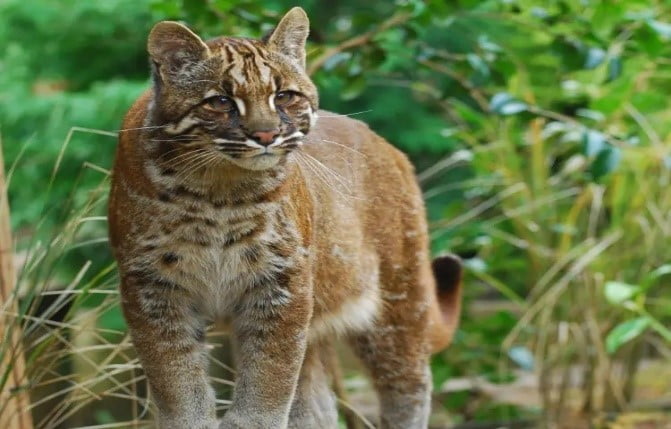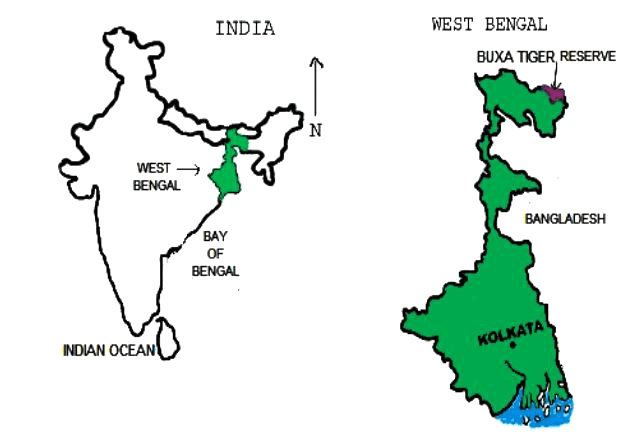Environment & Ecology
Context: For the first time, photos of melanistic Asian golden cat were captured through camera traps in West Bengal’s Buxa Tiger Reserve (BTR). In India, the melanistic morph has been earlier reported from north-eastern states including Sikkim, Assam and Arunachal Pradesh.
About Asiatic Golden Cat:

- The Asian golden cat (Catopuma temminckii ) is a medium-sized wild cat native to the Northeastern Indian subcontinent, Southeast Asia and China.
- The Asian golden cat’s scientific name honours Coenraad Jacob Temminck and is also called Temminck’s cat and Asiatic golden cat.
- Asian golden cats, known as the “fire cat” in Thailand and Burma, and as the “rock cat” in parts of China, are of a medium size and stocky build.
- Asian golden cats are solitary and territorial.
- Once considered nocturnal, a radio-tracking study showed them to be diurnal and crepuscular.
- Asian golden cats are carnivores, often eating small prey like Indochinese ground squirrel, small snakes and other reptiles, muntjacs, rodents, birds, and young hares.
- Asian golden cats are polygynous, which means that one male gets exclusive mating rights with multiple females.
- There appears to be no breeding season for the Asian golden cat, but from April to June no births occur.
- After gestation of about 81 days, 1 to 3 kittens are born.
- Kittens are weaned when they are 6 months old and they reach independence as early as 9 months, the average being 12 months.
- Female Asian golden cats reach sexual maturity between 18 and 24 months, males maturing at 24 months.
- Conservation Status:
- IUCN: Near threatened
- Wildlife Protection Act, 1972: Schedule I
About Buxa Tiger Reserve:

- Buxa Tiger Reserve (BTR) lies in Alipurduar sub-division of Jalpaiguri district of West Bengal.
- Its northern boundary runs along the international border with Bhutan.
- The Sinchula hill range lies all along the northern side of BTR and the Eastern boundary touches that of the Assam State.
- National Highway No.31 C roughly runs along its southern boundary.
- It is the eastern most extension of extreme bio-diverse North-East India and represents highly endemic Indo-Malayan region.
- The fragile “Terai Eco-System” constitutes a part of this Reserve.
- The Phipsu Wildlife Sanctuary of Bhutan is contiguous to North of BTR.
- Manas National Park lies on east of BTR.
- BTR, thus, serves as international corridor for elephant migration between India and Bhutan.
- Some of the endangered species found in BTR are Indian Tiger, Asian Elephant, Leopard cat, Bengal florican, Regal python, Chinese Pangolin, Hispid hare, Hog deer etc.
Source: Hindustan Times
Previous Year Questions
Q.1) With reference to Indian laws about wildlife protection, consider the following statements :
- Wild animals are the sole property of the government.
- When a wild animal is declared protected, such animal is entitled for equal protection whether it is found in protected areas or outside.
- Apprehension of a protected wild animal becoming a danger to human life is sufficient ground for its capture or killing.
Which of the statements given above is/are correct? (2022)
- 1 and 2
- 2 only
- 1 and 3
- 3 only
Q.2) Consider the following animals
- Hedgehog
- Marmot
- Pangolin
To reduce the chance of being captured by predators, which of the above organisms rolls up/roll up and protects/protect its/their vulnerable parts? (2021)
- 1 and 2
- 2 only
- 3 only
- 1 and 3














